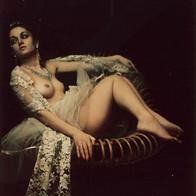Carlo Mollino
dal 28/8/2011 al 24/9/2011
Segnalato da
28/8/2011
Carlo Mollino
Kunsthalle Wien, Wien
The exhibition 'Un Messaggio dalla Camera Oscura' aims at shedding light on this ambivalence by confronting a selection of Mollino's Polaroid portraits with a number of extraordinary objects from the Museo Casa Mollino for the first time, which had also not been accessible to the public during the artist's lifetime. Curated by Gerald A. Matt.

Curated by Gerald A. Matt
"He was a performer, this all skiing all flying character. His body was covered in scars from all the crashes he’d had."
Simon Starling
He designed a racecar as a red double-torpedo for the legendary 24 Hours of Le Mans of 1955; he used the shape
of a female torso as the ground-plan of a theatre; he redesigned an apartment in a villa in Turin, where he did not
spend a single night, into a sort of Egyptian pyramid for the afterlife; a keen alpinist, he wrote a book on the
technique of downhill skiing and being an architect, he planned a cableway station and several mountain houses; he
created interiors and furniture in a style labeled “surreal engineering” for which collectors pay top prices; he was a
passionate pilot master in aerobatics; he published the first Italian historical and comprehensive book on
photography, “The message from the darkroom”; he loved the Classical World as much as Art Nouveau; he was
particularly fascinated by female sensitivity, both as a photographer and for his organic designs – talk is of Carlo
Mollino.
Born in 1905 into a Turin engineer’s well-to-do family, Carlo Mollino began to work in his father’s office after
graduating in architecture. He practiced as an architect throughout his life, though today he has become famous
above all for the furniture developed for his interior design projects. His pieces of furniture were hand made unique
pieces manufactured with the highest quality. Being financially independent, he could focus on his personal
researches, developing his projects in detail as an artist, in the spirit of the gesamtkunstwerk.
Mollino was part of the Modern Movement yet he constantly endowed design solutions linked to human models,
sophisticated, organic and psychological. This intellectual attitude found itself side by side with a deep interest for the
language of the female body – which he indulged in as a photographer: between 1962 and 1973, he shot over 1,000
polaroids portraying trough beauties of Turin’s night life the vision of an ideal woman. For this project he had
especially turned into a photographic studio a villa on the hills of Turin. In the 30’s Mollino acted as a photographer exhibiting in competitions and publishing his B&W portraits, in the 60’s he kept polaroids hidden from public eyes,
besides the one of his friends. These late portraits hold an enigmatic position within Carlo Mollino’s oeuvre. They
exemplify an intimate side of the universal artist who played presenting himself as a performer to the public and
secretly produced for himself the dearest and most needed representations, a self portrait.
The exhibition “Un Messaggio dalla Camera Oscura” aims at shedding light on this ambivalence by confronting a
selection of Mollino’s Polaroid portraits with a number of extraordinary objects from the Museo Casa Mollino for the
first time, which had also not been accessible to the public during the artist’s lifetime. His challenge with feminine forms springs just from a male erotic imagination or reflect something of his intellectual and artistic attitude as
expressed, for example, in his guiding principle: “everything is allowed as long as it is spurred by fantasy”?
The exhibition is prepared in collaboration with the Museo Casa Mollino, Turin.
Contact: KATHARINA MURSCHETZ
presse@kunsthallewien.at
+43-1-52189-1224
Opening: Monday, 29 August, 2011, 7 p.m.
Kunsthalle Wien
Treitlstraße 2, 1040 Vienna
Hours: Tue – Sat 1 p.m. to midnight, Sun and Mon 1 p.m. to 7 p.m



